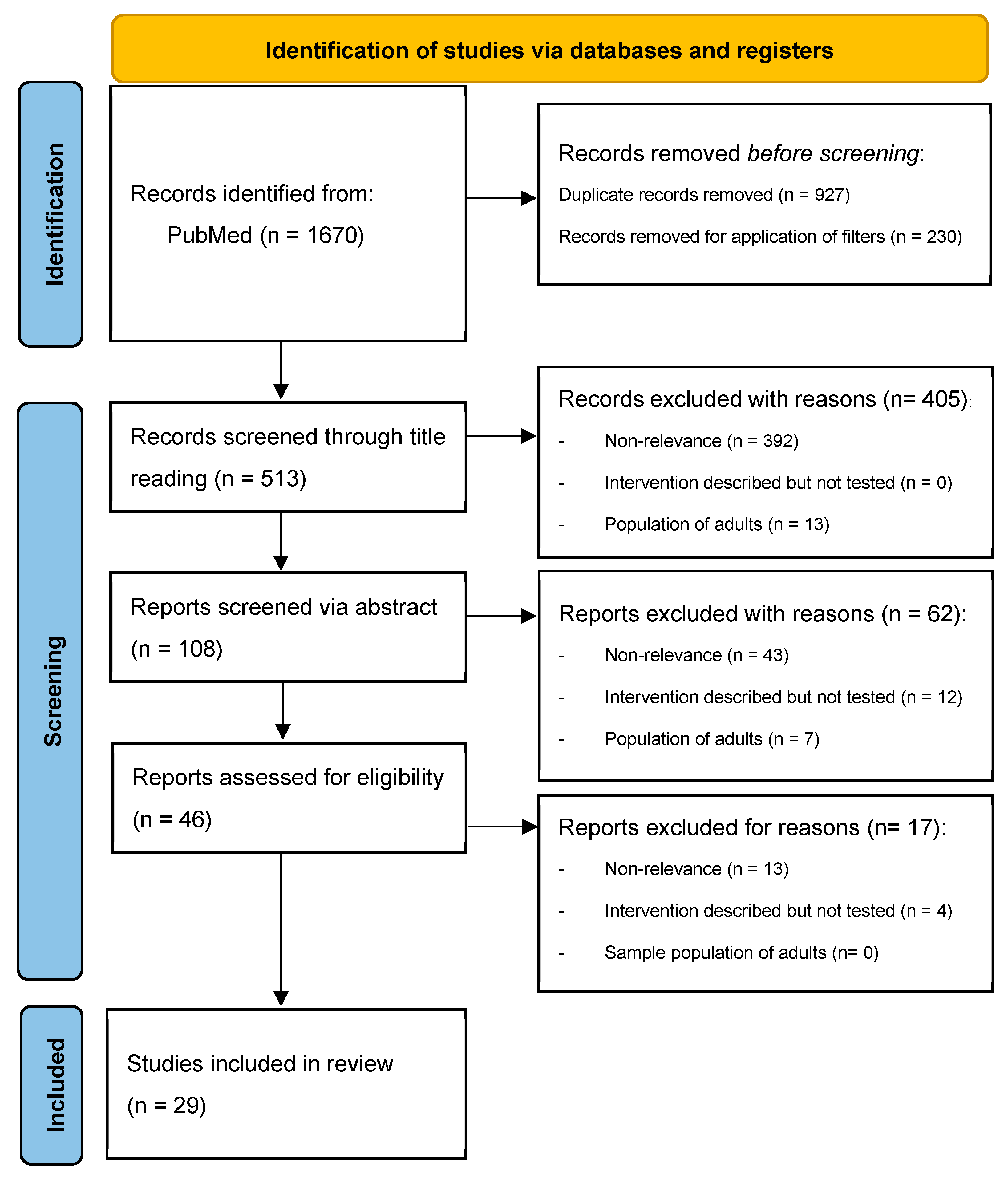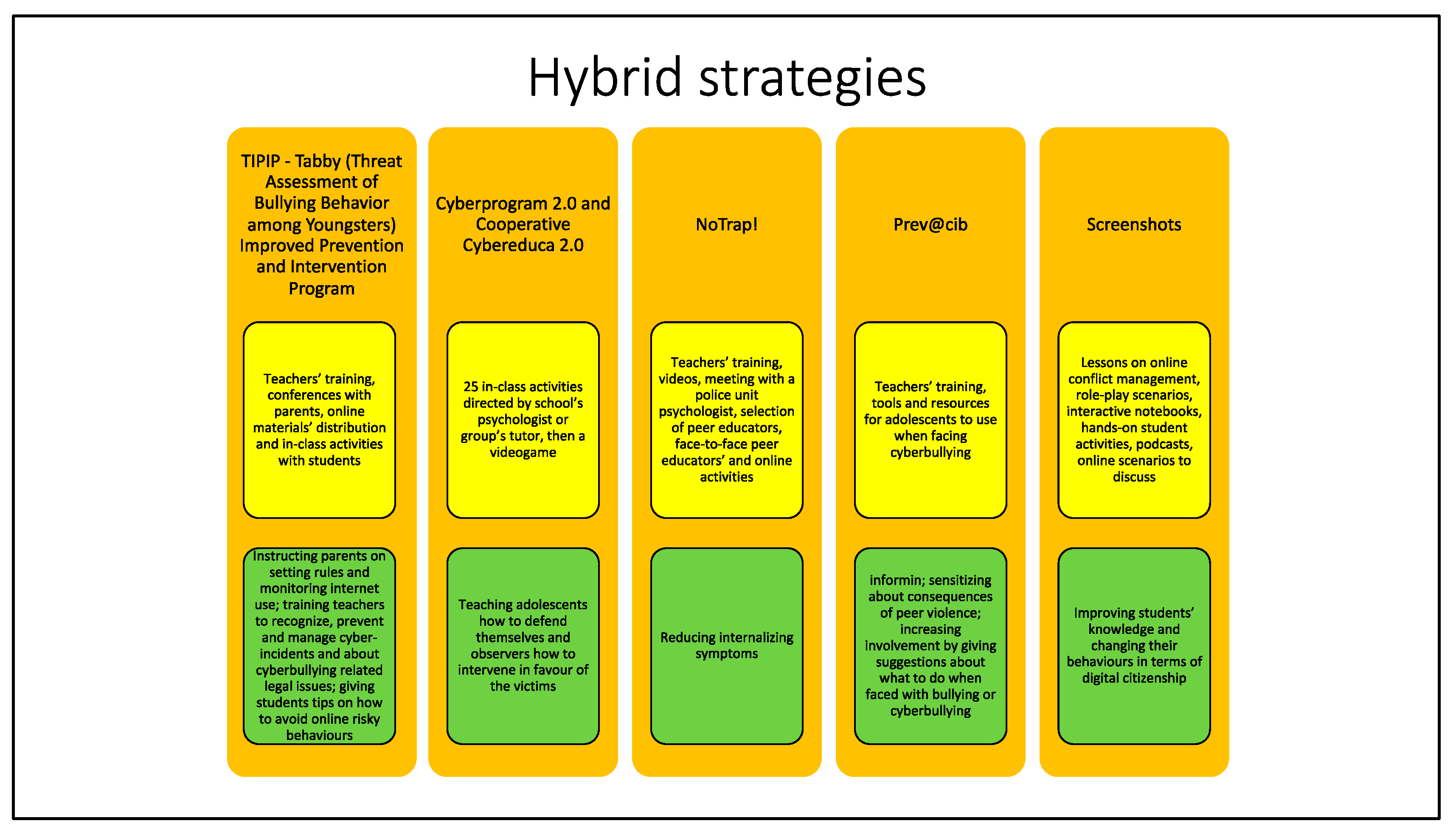Family and Educational Strategies for Cyberbullying Prevention: A Systematic Review
Abstract
:1. Introduction
2. Materials and Methods
3. Results
3.1. Educational Strategies
3.1.1. Educational Strategies Involving Schools
3.1.2. Educational Strategies Involving Families
3.1.3. Educational Strategies Involving Both Schools and Families
3.2. Digital Strategies
3.3. Hybrid Strategies
3.4. Other Strategies
4. Discussion
5. Conclusions
Author Contributions
Funding
Institutional Review Board Statement
Informed Consent Statement
Data Availability Statement
Conflicts of Interest
References
- World Health Organization. Report of the Consultation on Child Abuse Prevention, 29–31 March 1999, WHO, Geneva; World Health Organization: Geneva, Switzerland, 1999; Available online: https://apps.who.int/iris/handle/10665/65900 (accessed on 1 July 2022).
- Asamoah, M.K. The two side coin of the online social media: Eradicating the negatives and augmenting the positives. Int. J. Ethics Educ. 2019, 4, 3–21. [Google Scholar] [CrossRef]
- Cheng, C.; Lau, Y.C.; Luk, J.W. Social capital-accrual, escape-from-self, and time-displacement effects of internet use during the COVID-19 stay-at-home period: Prospective, quantitative survey study. J. Med. Internet Res. 2020, 22, e22740. [Google Scholar] [CrossRef]
- Kang, K.I.; Kang, K.; Kim, C. Risk factors influencing cyberbullying perpetration among middle school students in Korea: Analysis using the zero-inflated negative binomial regression model. Int. J. Environ. Res. Public. Health 2021, 18, 2224. [Google Scholar] [CrossRef]
- Alrajeh, S.M.; Hassan, H.M.; Al-Ahmed, A.S.; Alsayed Hassan, D. An investigation of the relationship between cyberbullying, cybervictimization and depression symptoms: A cross sectional study among university students in Qatar. PLoS ONE 2021, 16, e0260263. [Google Scholar] [CrossRef]
- Campbell, M.; Bauman, S. Reducing Cyberbullying in Schools; Elsevier: Amsterdam, The Netherlands, 2018. [Google Scholar]
- Smith, P.K. Making an Impact on School Bullying. Interventions and Recommendations; Routledge: New York, NY, USA, 2019. [Google Scholar]
- Smith, P.K.; Mahdavi, J.; Carvalho, M.; Fisher, S.; Russell, S.; Tippett, N. Cyberbullying: Its nature and impact in secondary school pupils. J. Child Psychol. Psychiatry 2008, 49, 376–385. [Google Scholar] [CrossRef]
- Tokunaga, R.S. Following you home from school: A critical review and synthesis of research on cyberbullying victimization. Comput. Hum. Behav. 2010, 26, 277–287. [Google Scholar] [CrossRef]
- Hinduja, S.; Patchin, J.W. Bullying Beyond the Schoolyard: Preventing and Responding to Cyberbullying, 2nd ed.; Corwin: Thousand Oaks, CA, USA, 2014. [Google Scholar]
- Ojanen, T.T.; Boonmongkon, P.; Samakkeekarom, R.; Samoh, N.; Guadamuz, T.E. Connections between online harassment and offline violence among youth in central Thailand. Child Abus. Negl. 2015, 44, 159–169. [Google Scholar] [CrossRef] [PubMed] [Green Version]
- Katzer, C.; Fetchenhauer, D.; Belschak, F. Cyberbullying: Who are the victims?: A comparison of victimization in internet chatrooms and victimization in school. J. Media Psychol. 2009, 21, 25–36. [Google Scholar] [CrossRef]
- Olweus, D. Aggression in the Schools: Bullies and Whipping Boys; Hemisphere: Washington, DC, USA, 1978. [Google Scholar]
- Parris, L.; Jungert, T.; Thornberg, R.; Varjas, K.; Meyers, J.; Grunewald, S.; Shriberg, D. Bullying bystander behaviors: The role of coping effectiveness and the moderating effect of gender. Scand. J. Psychol. 2020, 61, 38–46. [Google Scholar] [CrossRef] [PubMed]
- Feijóo, S.; Foody, M.; O’Higgins Norman, J.; Pichel, R.; Rial, A. Cyberbullies, the cyberbullied, and problematic internet use: Some reasonable similarities. Psicothema 2021, 33, 198–205. [Google Scholar] [CrossRef] [PubMed]
- Huang, J.; Zhong, Z.; Zhang, H.; Li, L. Cyberbullying in social media and online games among Chinese college students and its associated factors. Int. J. Environ. Res. Public Health 2021, 18, 4819. [Google Scholar] [CrossRef]
- González-Calatayud, V.; Prendes Espinosa, M.P. Role-based cyberbullying situations: Cybervictims, cyberaggressors and cyberbystanders. Int. J. Env. Res. Public Health 2021, 18, 8669. [Google Scholar] [CrossRef]
- Legge 29 Maggio 2017, n. 71-Disposizioni a Tutela Dei Minori per La Prevenzione Ed Il Contrasto Del Fenomeno Del Cyberbullismo. Available online: https://www.gazzettaufficiale.it/eli/id/2017/06/3/17G00085/sg (accessed on 1 July 2022).
- Page, M.J.; McKenzie, J.E.; Bossuyt, P.M.; Boutron, I.; Hoffmann, T.C.; Mulrow, C.D.; Shamseer, L.; Tetzlaff, J.M.; Akl, E.A.; Brennan, S.E.; et al. The PRISMA 2020 statement: An updated guideline for reporting systematic reviews. BMJ 2021, 372. [Google Scholar] [CrossRef]
- Schoeps, K.; Villanueva, L.; Prado-Gascó, V.J.; Montoya-Castilla, I. Development of emotional skills in adolescents to prevent cyberbullying and improve subjective well-being. Front. Psychol. 2018, 9, 2050. [Google Scholar] [CrossRef]
- Guarini, A.; Menin, D.; Menabò, L.; Brighi, A. RPC teacher-based program for improving coping strategies to deal with cyberbullying. Int. J. Environ. Res. Public Health 2019, 16, 948. [Google Scholar] [CrossRef] [Green Version]
- Ferrer-Cascales, R.; Albaladejo-Blázquez, N.; Sánchez-SanSegundo, M.; Portilla-Tamarit, I.; Lordan, O.; Ruiz-Robledillo, N. Effectiveness of the TEI program for bullying and cyberbullying reduction and school climate improvement. Int. J. Environ. Res. Public Health 2019, 16, 580. [Google Scholar] [CrossRef] [Green Version]
- Tiiri, E.; Luntamo, T.; Mishina, K.; Sillanmäki, L.; Brunstein Klomek, A.; Sourander, A. Did Bullying victimization decrease after nationwide school-based antibullying program? A time-trend study. J. Am. Acad. Child Adolesc. Psychiatry 2020, 59, 531–540. [Google Scholar] [CrossRef]
- Acosta, J.; Chinman, M.; Ebener, P.; Malone, P.S.; Phillips, A.; Wilks, A. Evaluation of a whole-school change intervention: Findings from a two-year cluster-randomized trial of the restorative practices intervention. J. Youth Adolesc. 2019, 48, 876–890. [Google Scholar] [CrossRef]
- Del Rey, R.; Ortega-Ruiz, R.; Casas, J. Asegúrate: An intervention program against cyberbullying based on teachers’ commitment and on design of its instructional materials. Int. J. Environ. Res. Public Health 2019, 16, 434. [Google Scholar] [CrossRef] [Green Version]
- Bonell, C.; Dodd, M.; Allen, E.; Bevilacqua, L.; McGowan, J.; Opondo, C.; Sturgess, J.; Elbourne, D.; Warren, E.; Viner, R.M. Broader impacts of an intervention to transform school environments on student behaviour and school functioning: Post hoc analyses from the INCLUSIVE cluster randomised controlled trial. BMJ Open 2020, 10, e031589. [Google Scholar] [CrossRef]
- Agley, J.; Jun, M.; Eldridge, L.; Agley, D.L.; Xiao, Y.; Sussman, S.; Golzarri-Arroyo, L.; Dickinson, S.L.; Jayawardene, W.; Gassman, R. Effects of ACT out! social issue theater on social-emotional competence and bullying in youth and adolescents: Cluster randomized controlled trial. JMIR Ment. Health 2021, 8, e25860. [Google Scholar] [CrossRef] [PubMed]
- Zafra, J.A.; Bonilla-Carrasco, M.I.; Carreiro-Alonso, M.A.; González-de Paz, L. Prevalence and self-report of bullying after in-class police orientation talk. Public Health Nurs. 2021, 38, 1131–1134. [Google Scholar] [CrossRef] [PubMed]
- Peng, Z.; Li, L.; Su, X.; Lu, Y. A Pilot intervention study on bullying prevention among junior high school students in Shantou, China. BMC Public Health 2022, 22, 262. [Google Scholar] [CrossRef] [PubMed]
- Bright, M.A.; Sayedul Huq, M.; Patel, S.; Miller, M.D.; Finkelhor, D. Child safety matters: Randomized control trial of a school-based, child victimization prevention curriculum. J. Interpers. Violence 2022, 37, 538–556. [Google Scholar] [CrossRef]
- Roberto, A.; Eden, J.; Deiss, D.; Savage, M.; Ramos-Salazar, L. The short-term effects of a cyberbullying prevention intervention for parents of middle school students. Int. J. Environ. Res. Public Health 2017, 14, 1038. [Google Scholar] [CrossRef] [Green Version]
- Zagorscak, P.; Schultze-Krumbholz, A.; Heinrich, M.; Wölfer, R.; Scheithauer, H. Efficacy of cyberbullying prevention on somatic symptoms—randomized controlled trial applying a reasoned action approach. J. Res. Adolesc. 2019, 29, 908–923. [Google Scholar] [CrossRef]
- Vivolo-Kantor, A.M.; Niolon, P.H.; Estefan, L.F.; Le, V.D.; Tracy, A.J.; Latzman, N.E.; Little, T.D.; Lang, K.M.; DeGue, S.; Tharp, A.T. Middle school effects of the dating matters® comprehensive teen dating violence prevention model on physical violence, bullying, and cyberbullying: A cluster-randomized controlled trial. Prev. Sci. 2021, 22, 151–161. [Google Scholar] [CrossRef]
- Martínez-Martínez, A.; Pineda, D.; Galán, M.; Marzo, J.C.; Piqueras, J.A. Effects of the action for neutralization of bullying program on bullying in Spanish schoolchildren. Int. J. Environ. Res. Public Health 2021, 18, 6898. [Google Scholar] [CrossRef]
- Przybylski, A.K.; Nash, V. Internet filtering technology and aversive online experiences in adolescents. J. Pediatr. 2017, 184, 215–219.e1. [Google Scholar] [CrossRef] [Green Version]
- Selkie, E.; Evans, Y.; Ton, A.; Midamba, N.; Moreno, M.A. Ideas for addressing electronic harassment among adolescents attending a video blogging convention. BMC Public Health 2018, 18, 973. [Google Scholar] [CrossRef]
- Calvete, E.; Orue, I.; Fernández-González, L.; Prieto-Fidalgo, A. Effects of an incremental theory of personality intervention on the reciprocity between bullying and cyberbullying victimization and perpetration in adolescents. PLoS ONE 2019, 14, e0224755. [Google Scholar] [CrossRef]
- Chillemi, K.; Abbott, J.-A.M.; Austin, D.W.; Knowles, A. A pilot study of an online psychoeducational program on cyberbullying that aims to increase confidence and help-seeking behaviors among adolescents. Cyberpsychol. Behav. Soc. Netw. 2020, 23, 253–256. [Google Scholar] [CrossRef]
- Kutok, E.R.; Dunsiger, S.; Patena, J.V.; Nugent, N.R.; Riese, A.; Rosen, R.K.; Ranney, M.L. A cyberbullying media-based prevention intervention for adolescents on instagram: Pilot randomized controlled trial. JMIR Ment. Health 2021, 8, e26029. [Google Scholar] [CrossRef]
- Ortega-Barón, J.; González-Cabrera, J.; Machimbarrena, J.M.; Montiel, I. Safety.Net: A pilot study on a multi-risk internet prevention program. Int. J. Environ. Res. Public Health 2021, 18, 4249. [Google Scholar] [CrossRef]
- Ranney, M.L.; Pittman, S.K.; Moseley, I.; Morgan, K.E.; Riese, A.; Ybarra, M.; Cunningham, R.; Rosen, R. Cyberbullying prevention for adolescents: Iterative qualitative methods for mobile intervention design. JMIR Form. Res. 2021, 5, e25900. [Google Scholar] [CrossRef]
- Sorrentino, A.; Baldry, A.; Farrington, D. The efficacy of the tabby improved prevention and intervention program in reducing cyberbullying and cybervictimization among students. Int. J. Environ. Res. Public Health 2018, 15, 2536. [Google Scholar] [CrossRef] [Green Version]
- Garaigordobil, M.; Martínez-Valderrey, V. Technological resources to prevent cyberbullying during adolescence: The cyberprogram 2.0 program and the cooperative cybereduca 2.0 videogame. Front. Psychol. 2018, 9, 745. [Google Scholar] [CrossRef]
- Palladino, B.E.; Nocentini, A.; Menesini, E. How to stop victims’ suffering? indirect effects of an anti-bullying program on internalizing symptoms. Int. J. Environ. Res. Public Health 2019, 16, 2631. [Google Scholar] [CrossRef] [Green Version]
- Ortega-Barón, J.; Buelga, S.; Ayllón, E.; Martínez-Ferrer, B.; Cava, M.-J. Effects of intervention program Prev@cib on traditional bullying and cyberbullying. Int. J. Environ. Res. Public Health 2019, 16, 527. [Google Scholar] [CrossRef] [Green Version]
- Bickham, D.S.; Moukalled, S.; Inyart, H.K.; Zlokower, R. Evaluating a middle-school digital citizenship curriculum (screenshots): Quasi-experimental study. JMIR Ment. Health 2021, 8, e26197. [Google Scholar] [CrossRef]
- Hatzenbuehler, M.L.; Flores, J.E.; Cavanaugh, J.E.; Onwuachi-Willig, A.; Ramirez, M.R. Anti-bullying policies and disparities in bullying: A state-level analysis. Am. J. Prev. Med. 2017, 53, 184–191. [Google Scholar] [CrossRef] [Green Version]
- Sampasa-Kanyinga, H.; Colman, I.; Goldfield, G.S.; Janssen, I.; Wang, J.; Hamilton, H.A.; Chaput, J.-P. Associations between the Canadian 24 h movement guidelines and different types of bullying involvement among adolescents. Child Abus. Negl. 2020, 108, 104638. [Google Scholar] [CrossRef]
- Slonje, R.; Smith, P.K.; Frisè, A. The nature of cyberbullying, and strategies for prevention. Comput. Hum. Behav. 2013, 29, 26–32. [Google Scholar] [CrossRef]
- Mason, K.L. Cyberbullying: A preliminary assessment for school personnel. Psychol. Sch. 2008, 45, 323–348. [Google Scholar] [CrossRef]
- Aboujaoude, E.; Savage, M.W.; Starcevic, V.; Salame, W.O. Cyberbullying: Review of an old problem gone viral. J. Adolesc. Health 2015, 57, 10–18. [Google Scholar] [CrossRef]
- Olweus, D. Cyberbullying: An overrated phenomenon? Eur. J. Dev. Psychol. 2012, 9, 520–538. [Google Scholar] [CrossRef]







Publisher’s Note: MDPI stays neutral with regard to jurisdictional claims in published maps and institutional affiliations. |
© 2022 by the authors. Licensee MDPI, Basel, Switzerland. This article is an open access article distributed under the terms and conditions of the Creative Commons Attribution (CC BY) license (https://creativecommons.org/licenses/by/4.0/).
Share and Cite
Tozzo, P.; Cuman, O.; Moratto, E.; Caenazzo, L. Family and Educational Strategies for Cyberbullying Prevention: A Systematic Review. Int. J. Environ. Res. Public Health 2022, 19, 10452. https://doi.org/10.3390/ijerph191610452
Tozzo P, Cuman O, Moratto E, Caenazzo L. Family and Educational Strategies for Cyberbullying Prevention: A Systematic Review. International Journal of Environmental Research and Public Health. 2022; 19(16):10452. https://doi.org/10.3390/ijerph191610452
Chicago/Turabian StyleTozzo, Pamela, Oriana Cuman, Eleonora Moratto, and Luciana Caenazzo. 2022. "Family and Educational Strategies for Cyberbullying Prevention: A Systematic Review" International Journal of Environmental Research and Public Health 19, no. 16: 10452. https://doi.org/10.3390/ijerph191610452
APA StyleTozzo, P., Cuman, O., Moratto, E., & Caenazzo, L. (2022). Family and Educational Strategies for Cyberbullying Prevention: A Systematic Review. International Journal of Environmental Research and Public Health, 19(16), 10452. https://doi.org/10.3390/ijerph191610452






